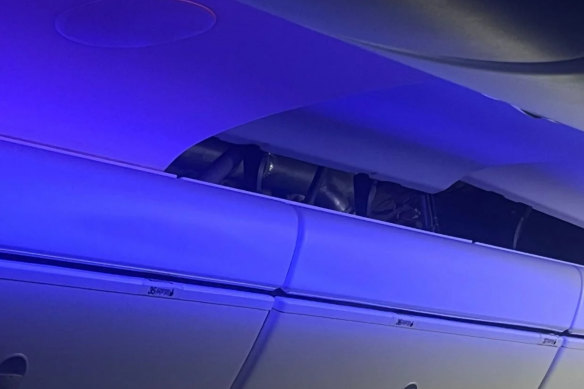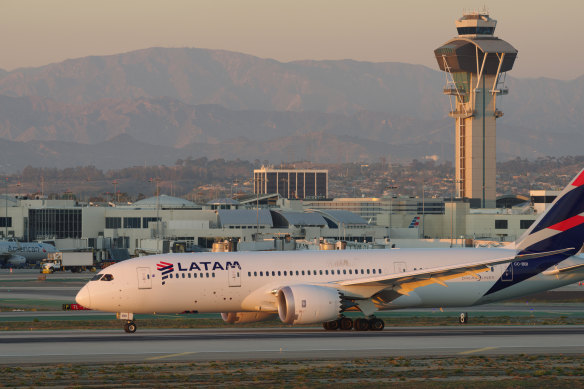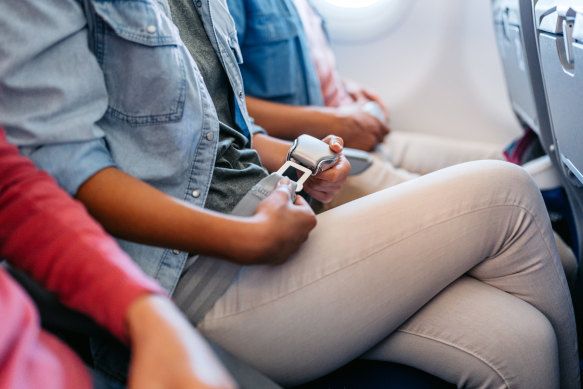Seatbelts on: Warning over likelihood of more unexpected bumps on planes
Airline passengers should be prepared for more bumps and turbulence in future, according to aviation experts, and have been urged to leave their seatbelts on whenever seated on flights.
The oft-ignored plea of flight crew, to always fasten seatbelts while seated, has taken on new resonance following Monday’s LATAM Airlines flight from Sydney to Auckland, which suddenly dropped altitude over the Tasman Sea, injuring 50 of 272 on board.
Thirteen people, three crew and 10 passengers, including four Australians, were hospitalised over the incident. Now industry experts are calling for travellers to buckle up, amid fears future increases in turbulence will lead to more hospitalisations.

One passenger described how people flew into the ceiling during the “sudden movement”.
Passenger Brian Jokat described the panicked moment the eight-year-old Boeing 787-9 Dreamliner “dropped out of the sky” sending people – including his seat neighbour – flying into the ceiling.
“The whole plane is screaming. The plane then started taking a nose dive and I was just thinking ‘OK, this is it, we’re done’,” he told Stuff.
Jokat didn’t sustain any injuries; he had his seatbelt on at the time.
Had he been using the cabin bathroom during the jolt, like another male passenger who reemerged from the toilet with blood streaming down his face, he may not have escaped unscathed.

LATAM’s Boeing 787-9 Dreamliner is now under investigation by Chilean authorities.Credit: iStock
In a statement issued by LATAM, the South American airline cited a “technical problem” that resulted in “strong movement”. The incident is now under investigation by Chile, who will focus on human error or technical fault, as New Zealand authorities seize cockpit voice recordings and flight data.
As Boeing and Chile authorities work to gather more intel, should Australians be buckling up as a matter of course?
According to data from the Australian Transport Safety Bureau (ATSB), between 2014 and 2023 commercial aircraft (categorised as high-capacity passenger flights) reported 1181 incidents related to technical issues (mostly minor issues, resolved by flight crew without major incident), and 365 incidents related to turbulence.
In reality, commercial aircraft incidents are extremely rare today; in fact, the aviation industry achieved a safety milestone in 2023, with the lowest all-accident rate in more than a decade. However, turbulence is an area of growing concern.

The LATAM incident, which hospitalised 13 people, highlights the importance of buckling up mid-flight.Credit: iStock
Professor Rico Merkert, an aviation expert at the University of Sydney, said technical aircraft issues resulting in incidents, as in the LATAM flight, are extremely rare. However, fastening seatbelts during flights is a highly sensible precaution, with aircraft contending with more unstable “air pockets”, descending air currents that can cause a plane to drop abruptly.
“Flying, especially long-haul, is still by far the safest mode of transport. That said, flight turbulences are getting more common and also more severe,” said Merkert.
“Airlines use jet streams [strong winds that help planes travel faster], and due to climate change, there are now more air pockets.”
A 2023 analysis from the University of Reading in the UK found that the frequency of in-clear-air turbulence, a type of invisible turbulence, considered the most dangerous for an aircraft, is increasing, due to warmer air from CO² emissions, which are known to increase wind shear (sudden changes in wind) in jet streams.
The study, which measured the frequency of turbulence over a 40-year period, showed that one of the world’s busiest flight routes over the North Atlantic Ocean had experienced a 55 per cent increase in severe turbulence since 1979, with significant increases in moderate to light turbulence too (37 per cent and 17 per cent respectively).
It’s something travellers will need to be more wary of in the future, particularly when flying long haul or over bodies of water, where air pockets are more common due to ocean surface winds, air-sea cooling and evaporation.
Increases in the frequency of heat waves and rising temperatures will translate to bumpier flights, as aircraft experience shifts in wind shear while ascending from hotter air trapped near the ground to cooler air above.
The notion of seatbelts slowing you down in the event you need to evacuate has been largely debunked by industry experts, whereas during deceleration, turbulence and unpredictable conditions, a seatbelt could be life-saving.
According to Civil Aviation Safety Regulations 1998 (CASR), which oversee the aviation safety framework in Australia, seatbelts must be worn by all crew members and passengers during various circumstances including take-off and landing, when the aircraft is flying at a height of less than 1000 feet (305 metres — though airlines will typically request passengers to buckle up much higher than this, once landing preparations begin), and at all times in turbulent conditions.
Merkert’s advice is simple: “Listen to the safety advice and instruction of your airline and wear your seatbelt.”
Sign up for the Traveller newsletter
The latest travel news, tips and inspiration delivered to your inbox. Sign up now.